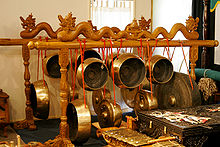Gamelan jegog
| Music of Indonesia | |
|---|---|

Kempul gongs from Java
|
|
| Genres | |
| Specific forms | |
| Regional music | |
Jegog is a form of gamelan music indigenous to Bali, Indonesia played on instruments made of bamboo. The tradition of jegog is centered in Jembrana, a region in Western Bali. In recent years jegog has started to become popular in other regions of Bali with a few groups being established in central Bali to entertain tourists. International interest has been spread by tourists visiting Bali and by recordings. There are virtually no ensembles outside of Bali with the exception of at least two groups in Japan (Sekar Sakura and Geinoh Yamashirogumi, the latter's having been used in 4 of the tracks in their score for the film Akira as well as on the final track of Ecophony Rinne ), one in the United States (Sekar Jaya) and one in Germany. Jegog music is very fast, loud, rhythmic and precise. Pieces last from a few minutes to as long as thirty minutes.
Jegog instruments have a four note scale that roughly corresponds to the four pitches of a dominant 7th chord in Western music. All instruments have eight bamboo keys. Some instruments have two keys for each pitch slightly detuned so that the pitches beat when they are played together. Other instruments have a two octave range with four pitches in a low octave and the same four pitches an octave higher. In this case the instrument will be paired with another instrument that is slightly detuned. Taken together the ensemble has a range of five octaves.
Most Jegog ensembles have instruments that have keys that are made of bamboo that are split at one end and then half of the tube is removed. The other end remains intact and functions as a resonator for the split part. The keys are suspended on a wooden frame and struck with mallets (called pangguls), made out of wood or rubber. There are also Jegog ensembles with instruments called Jegog Tingklik. These smaller instruments are used primarily with children. The keys are made of bamboo slats mounted above a resonator box.
The lowest instrument in a Jegog ensemble is also called a Jegog. The ensemble gets its name from this instrument. The keys of the Jegog instrument are as long as 3 meters in length and a pitch as low as 60 hertz. The instrument is so large, and the mallets are so heavy that it takes two people to play it. The players crouch on a platform on the top of the instrument and alternate playing the keys. The Jegog instrument has the lowest octave of the ensemble. Each pair of pitches are detuned by as much as 7 hertz. In this octave, that is almost a whole tone. The keys are arranged 1' 2' 3' 4' 1 2 3 4, one being the lowest pitch and 4 being the highest. The four keys on the left are the higher pitches of the detuned pairs and the four on the right are the lower ones.
...
Wikipedia
